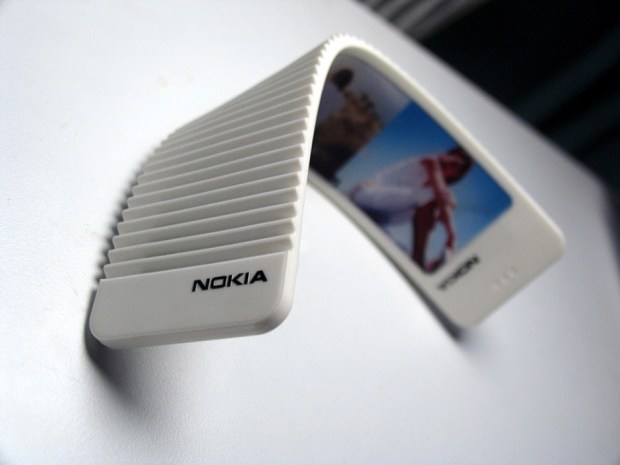
Long before the iPhone changed how we think of cellphones, Nokia was dabbling in even more radical cellphone concepts.
[aditude-amp id="flyingcarpet" targeting='{"env":"staging","page_type":"article","post_id":626904,"post_type":"story","post_chan":"none","tags":null,"ai":false,"category":"none","all_categories":"business,mobile,","session":"D"}']The Nokia 888, a concept from designer Tamer Nakisci, was a flexible design that could fit around your wrist, lay flat for reading, and take on a few other shapes. I haven’t thought much about the 888 since it won Nokia’s Benelux design contest in 2005, but after AppleInsider dug up Apple’s slapband-esque iWatch patent yesterday (below), Nakisci’s concept feels strangely relevant.
AI Weekly
The must-read newsletter for AI and Big Data industry written by Khari Johnson, Kyle Wiggers, and Seth Colaner.
Included with VentureBeat Insider and VentureBeat VIP memberships.
To be clear, I’m not implying Apple in any way stole this design concept. It’s just interesting to see how close we are today toward building devices that once seemed impossible.
Here’s how Nakisci described the functionality of the 888’s form to Yanko Design:
You don’t have to carry it in your pocket or on your wrist. You can carry it anywhere, in any form. You can roll it, bend it, put on your clothes like a clip. It also makes some form changes that makes it more ergonomical: i.e., when you want to talk on the phone, the body form turns into the form of the good old telephone. You can personalize these forms and record them. So it fits you the best in the way that you have chosen. The functions that it has also create a feeling of electronical pet, as it senses your moves, understands what you want, responds to you in the best way. It learns you, to fit you better. Also e-motions lets you send forms to the other 888 users. It could be the shape of a heart or a small dance. This way you can talk without words.
Like any great concept design, Nakisci’s vision was far beyond the technology available at the time. It may even be too advanced to build today; Apple’s iWatch concept still relies on a wireless connection with your iPhone to fetch data, which removes the need for bulky cellular electronics and a bigger battery.
Here’s how Apple describes its “slapband” iWatch patent (which, of course, isn’t called iWatch anywhere in the patent):
A wearable video device arranged to be worn by an end-user, comprising: a flexible substrate having a flat state and a curled state; a flexible display disposed upon a first surface of the flexible substrate, wherein in the curled state the flexible substrate conforms to an appendage of the end-user, the flexible substrate further comprising: an electronic module in communication with the flexible display, the electronic module providing information to the display, at least a part of which is presented in real time for presentation by the flexible display; and a mechanism for detecting an end portion of the flexible display, the detection for adjusting the arrangement of information shown on the flexible display to match the size of the appendage the wearable video device is mounted on.
[aditude-amp id="medium1" targeting='{"env":"staging","page_type":"article","post_id":626904,"post_type":"story","post_chan":"none","tags":null,"ai":false,"category":"none","all_categories":"business,mobile,","session":"D"}']
VentureBeat's mission is to be a digital town square for technical decision-makers to gain knowledge about transformative enterprise technology and transact. Learn More
